Perfect food
Breastfeeding is the natural, biological way of providing babies with nutrients required for healthy growth and development.
Better for mum, better for baby
Breastfeeding helps with mother and baby emotional attachment and is better for both short and long term health.
Environmentally friendly
Breast milk has no waste products, so it is better for the environment.
For mothers
Higher risk of:
More expensive:
For babies
Higher risk of:
For the community
Babies know when they are hungry and thirsty. Babies know when the milk comes in. Babies know how to breastfeed.
Allowing babies to do what they were born to do, will make for a much smoother transition into this new world; for mother and baby.
More information:
The World Health Organization and the National Health and Medical Research Council (NHMRC) recommend you breastfeed your baby exclusively for the first six months. Breast milk is all the food and drink that a baby needs.
The Australian Dietary Guidelines (NHMRC) recommends:
The Baby-friendly Hospital Initiative (BFHI) was developed by the World Health Organisation and UNICEF in 1991. It is a worldwide program aiming to create a healthcare environment that supports mothers and babies to have the best start in life.
Queensland Health is proud to support the BFHI. We promote breastfeeding as the optimal way to feed your baby; however we also respect how you choose to feed your baby.
Think about what is important for you.
It is never too early to read, learn and talk about breastfeeding.
Most people have a view about breastfeeding before having their baby. What have you heard from friends, television, or in the community?
Learning about the changes in your breasts during pregnancy may give you a better understanding of your body’s ability to breastfeed. The good news is, no physical preparation is required!
Most women notice breast changes in pregnancy, however some do not. Your breasts will usually increase in size – as the due date approaches, hormone changes cause your breasts to feel larger and tender. Sometimes, visible veins appear. In the third trimester, some pregnant women begin to leak colostrum from their breasts.
Your breasts are filled with milk making glands that are called alveoli. This is where your milk is produced. The milk travels from the alveoli through a series of milk ducts to the nipple openings.
The more often your baby breastfeeds, the more milk your breasts make.
When your baby breastfeeds, your brain releases two hormones.
Prolactin is the hormone that causes your breasts to make milk.
Oxytocin helps with your letdown reflex (release of milk). These hormones also increase the level of bonding and comfort you feel during breastfeeding.
When your baby latches on and begins to breastfeed, the alveoli release milk. This is called the let down or milk ejection reflex. Let down occurs several times during a feed. In the early days, you may not even notice this is happening.
How can I tell if my milk is letting down?
More information: Australian Breastfeeding Association – Breastfeeding Information
Most women can breastfeed with the right information, support and practice.
Speak to your midwife, doctor or lactation consultant if any of the following applies to you:
More information: Australian Breastfeeding Association
Most babies will attach to the breast for their first feed if placed skin to skin (in contact) with their mother.
Skin to skin contact
This is when your baby is placed directly from birth onto your chest or abdomen. Your newborn’s skin touches your skin. A blanket or towel can be placed over the baby’s back for warmth if required. Providing baby and you are well, skin to skin contact should continue, undisturbed, until the first breastfeed. Routine procedures such as bathing and weighing can wait.
If you can’t have skin to skin right after the birth, this is often due to medical reasons.
Your midwife will support skin to skin contact as soon as possible.
More information: Queensland Clinical Guidelines parent information – Breastfeeding your baby
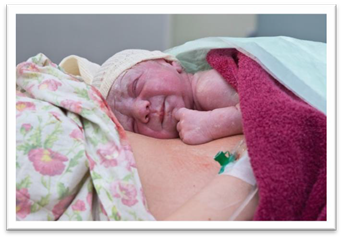
Most healthy babies will want to feed within the first 90 minutes after birth.
During skin to skin contact, your baby will show feeding signs (cues).
When this happens, position baby close to your breast.
After your baby is born, you will both be in the same room – you will be able to see signs that your baby is hungry, uncomfortable or needs to be cuddled.
Benefits of rooming in:
Newborn feeding behaviour
Birth to two hours
Baby is usually awake and alert (best time to feed).
The first 24 hours
Two to 20 hours after birth, baby will have light and deep sleep (may not want to feed often).
After 20 hours
Baby will have sleep and awake behaviour (and may want to feed often).
Day two to three
Your baby may seem unsettled on day two or three while your colostrum changes to mature milk. Increased breastfeeding is often all that is needed.
More information: NHS – Breastfeeding: the first few days
Mothers can follow their baby's lead in how often to breastfeed.
Rather than watching the clock, watch for cues that your baby is hungry such as the rooting reflex, chewing/sucking on hands or fingers.
Early feeding cues (signs) are the best time to feed!
Early cues: “I’m hungry” (stirring, mouth opening, turning head and seeking/rooting).
Mid-cues: “I’m really hungry” (stretching, increasing physical movement, hand to mouth).
Late cues: “Calm me, then feed me” (crying, agitated body movements, colour turning red).
The first milk is called colostrum. This special milk is yellow in colour, thick and sticky. It may be low in volume but it is high in concentrated nutrition for your newborn.
Colostrum has a laxative effect on baby, helping him or her pass the early stools and helping to prevent jaundice.
The more you feed your baby, the more milk you will make (supply = demand).
Days after birth | Type of milk | How it looks |
Birth to day 2 or 3 | Colostrum | Thick, yellow in colour, small amount |
Days 3 to 5 | Transitional milk | Mixture of colostrum and mature milk more plentiful |
Days 5 to 7 | Mature milk begins | Thinner, whitish, plentiful |
You may find that your breasts become larger and feel heavy, warmer and uncomfortable when your milk ‘comes in’; usually about two to four days after your baby is born.
Your milk will then increase in volume and will generally begin to appear thinner and whiter in colour.
Whenever baby is hungry!
Healthy, full-term newborns should breastfeed eight to 12 times in each 24 hour period. Many mothers are surprised at how quickly and easily human milk is digested, often within 90 minutes of the last feed.
Many babies do what is called 'cluster feeding’, spacing feeds closer together at certain times of the day (usually during the evening). This is normal. As babies grow and their stomachs become larger, they begin to go longer between feeds and develop more regular feeding patterns.
Your baby will determine this.
A typical feed might last about 20–30 minutes. In the beginning, it could take up to an hour.
It is important that you allow the baby to feed for as long as the baby wants on one side.
Do not time the feed or swap sides unless the baby seems to have finished one side. This will ensure that your baby feeds well and helps with your breast milk supply.
If the baby takes only one breast, remember to offer the other breast at the next feed.
When your baby has had enough, they will stop sucking and come off the breast or simply fall asleep. If you notice that baby's jaw isn't moving anymore, you can detach baby. Your breasts keep making milk.
Remember, supply = demand.
A common concern to breastfeeding mothers is how to tell whether their baby is getting enough milk.
Your baby will tell you by:
Seek advice from a healthcare professional if you have concerns.
Age | Feeds per day | Wet nappies | Dirty nappies |
Day 1 | 3–8 | 1 | 1 Black, tarry and sticky |
Day 2 | 5–10 | 2–3, may contain urates. What are urates? Crystals present in strong urine that stain a nappy reddish-orange. | 1–2 Greenish–black, softening |
Day 3 | 5–10 | 3–4 paler, but may be concentrated and contain urates. | 3–4 Greenish–yellow, soft |
Day 4 | 5–-10 | 4–6 pale, no urates. | 4 large or 10 small Yellow and/or seedy, soft/liquid |
Day 5 | 8–12 | More than 6 pale nappies. | 4 large or 10 small Yellow and/or seedy, soft/liquid |
The key to successful breastfeeding is comfortable positioning and good attachment.
Make sure your baby is well attached to the breast. If your baby is only attached to the nipple, breastfeeding will be painful.
If your baby is well-attached to your breast, you are less likely to experience breastfeeding problems like cracked nipples, and your baby will get the most amount of milk from your breast.
Find a comfortable place where you can sit and relax. Have everything you might need close to hand – e.g. phone, glass of water. Breastfeeding may take some time.
This webpage is currently being reviewed and some outdated content has been removed. Please refer to Raising Children Breastfeeding videos and Raising Children Breastfeeding positions in pictures in the interim.
Some tips which may help:
More information: Raising Children Network – Breastfeeding positions: in pictures
Video: Raising Children Network – Breastfeeding: getting a good attachment
Your baby is not attached if:
Avoid pulling your baby away from your breast. Instead, break the attachment by inserting your little finger into the corner of your baby’s mouth, between the gums, and gently remove your baby from the breast.
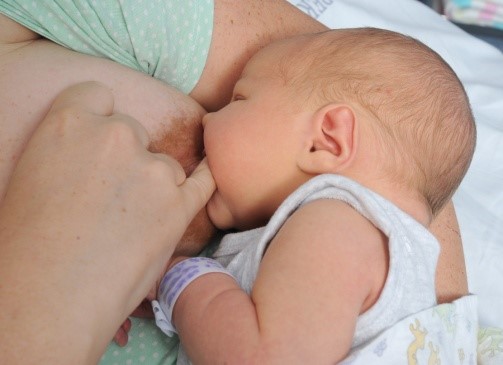

Front hold or cradle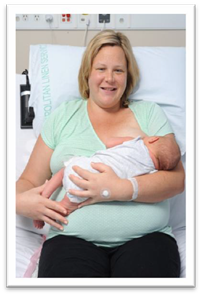
Underarm or football hold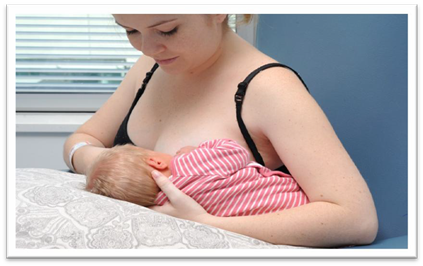
Side lying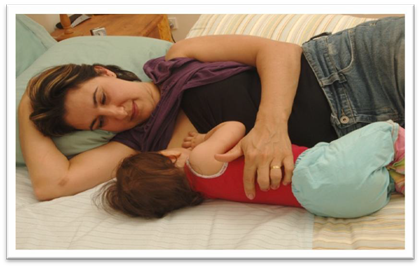
Video: Raising Children Network – How to breastfeed: breastfeeding positions
More information: Australian Breastfeeding Association – Attachment to the breast
Why is my baby’s skin yellow?
Jaundice in the first week of life occurs in 60% of healthy newborn infants. It typically occurs between day two to four after birth and is usually cleared by the first week.
Frequent feeding is the best prevention. If a baby appears to be jaundiced, a blood test can determine the level of bilirubin. Treatment, if any, will depend on the level of bilirubin, how the baby is feeding and how old the baby is. Jaundice appears first on the face and head. If the level of bilirubin goes higher, it will appear on the body, and if it goes even higher it will be on the palms of the hands and soles of the feet.
More information: Queensland Clinical Guidelines parent information – Jaundice in newborn babies
If you’re breastfeeding, it’s a good idea to avoid using a dummy until breastfeeding is established. This is usually when your baby is four to six weeks old.
Using a dummy (also known as a pacifier) when you plan to breastfeed can:
More information: Queensland Clinical Guidelines parent information – Breastfeeding your baby
Partners of new mothers play an important role, they can:
More information:
Video: ACT Government Health – Breastfeeding Give it a Go
Healthy eating is important when you are breastfeeding.
Your body has a greater need for most nutrients; to meet these needs it is important to eat a healthy, well-balanced diet based on a range of healthy foods and plenty of water.
More information: Queensland Health – Nutrition Education Materials Online (NEMO)
Smoking is not recommended while breastfeeding.
Smoking can affect the nutrient content of breastmilk and reduce supply. It also increases the risk of SIDS (sudden infant death syndrome).
Avoid exposing baby to tobacco smoke. Don't let anyone smoke near your baby – whether in the house, car or anywhere else your baby spends time.
For advice and support visit QUIT HQ or call Quitline on 13 78 48.
Alcohol
The safest option is to avoid drinking alcohol while breastfeeding.
Caffeine
Breastfeeding mothers can safely consume caffeine, but they should consume less caffeine than non-breastfeeding women, to protect their health and the health of their breastfed baby.
If you have an existing medical condition or are taking an over-the-counter or prescribed medication, discuss this with your health professional.
Always discuss alternative/natural and complementary therapies, as they may not be safe during breastfeeding.
Always check with your doctor or pharmacist regarding prescription and over-the-counter medications when you are breastfeeding.
More information: Australian Breastfeeding Association – Common concerns - baby
Many women experience some difficulties when establishing breastfeeding.
Most are minor and can be overcome by advice, assistance and support.
Your midwife or a lactation consultant will be happy to help.
For advice contact:
About three days after having a baby, many mothers will experience breast fullness as their milk 'comes in'. Occasionally a mother may need to express a small amount of milk to soften the breast before a feed. This fullness usually only lasts for 24 hours and is different to engorgement.
When it comes to breastfeeding, remember that supply equals demand. The more you feed your baby, the more milk your breasts will make.
Ways to increase or maintain a good milk supply include:
Nipples can be sensitive in the beginning, but breastfeeding should not be painful through a whole feed or continue to be painful.
Helpful hints to avoid sore nipples:
Cracked/bleeding nipples:
If your nipples are cracked or bleeding it is recommended that you seek help from a health care provider.
Mastitis is an inflammation and/or infection of the breast tissue.
Mastitis can be caused by:
Signs of mastitis
Management of mastitis
More information:
Practical support
Involve your family and friends who can provide a network of help with babysitting, social activities and ‘time out’ for you.
Personal support
Talk to friends, family and support groups about how you are feeling.
Information support
Seek information from health professionals, books, websites etc. It can be challenging for you to identify what information is based on the latest recommendations, so be wary of the source of information.
The return of the menstrual cycle is different for every woman.
Even if you are exclusively breastfeeding, you can start ovulating. That means you can get pregnant again without even knowing that it has happened.
Ask your healthcare professional about your family planning options and if they are compatible with breastfeeding.
The Australian Breastfeeding Association has useful information on breastfeeding and work.
Crying is an important means of communication for young babies. Babies always cry for a reason. These include:
Parenting and adjusting to a new baby is rewarding, but it can also bring significant changes and challenges.
If you or your partner are struggling to cope, there is help available. Call and talk to a relative, friend or visit your Child Health Centre, GP, or health professional.
More information:
Most baby’s wake and feed at night until about six months of age.
There is a large variation of what is ‘normal’. Prolactin (milk making hormone) levels are highest at night, so night feeds are important to ensure adequate stimulation and milk removal from the breast.
Night feeds are important because they:
More information:
Breastfeeding, 23 Mar 2023, [https://oss-uat.clients.squiz.net/health/children/pregnancy/antenatal-information/breastfeeding-101]
This document is uncontrolled when printed. Before using the information in this document you should verify the current content on https://oss-uat.clients.squiz.net/health/children/pregnancy/antenatal-information/breastfeeding-101.